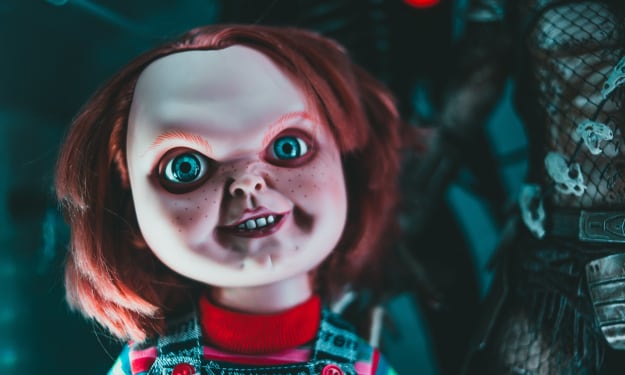18th Century !!!!
A Haunted Typewriter machine

In the late 18th century, a young woman named Mary inherited a grand manor from her late grandfather. Despite its size and beauty, the manor held a dark secret that had been kept hidden for years. It all began when Mary discovered an old typewriter that had belonged to her grandfather. Thinking that it might be worth something, she decided to take it home with her. Little did she know that this decision would set off a chain of events that would change her life forever. Soon, she found herself haunted by the typewriter, which seemed to have a life of its own. It would tap out messages in the dead of night, filling her with a sense of dread and unease. Mary tried to get rid of the machine, but it always found its way back to her doorstep, more malevolent than ever. As she delved deeper into the manor's history, she discovered that the typewriter was only the beginning of the horrors that lay hidden within the walls of the manor.
In the year of 18th century, there was a small town nestled in the English countryside. It was a picturesque place, with cobblestone streets and thatched roofs. In the center of the town was a large, imposing manor house, which belonged to the eccentric Lord Hastings. Despite his wealth and status, Lord Hastings was a solitary man who spent most of his time holed up in his study, surrounded by his collection of rare books and antiques.
One day, Lord Hastings received a mysterious package in the mail. It was an antique typewriter machine, with ornate gold lettering and a strange aura about it. Lord Hastings was intrigued by the machine and decided to keep it in his study, where he spent most of his days.
At first, the typewriter seemed to be nothing more than a curiosity. But as time passed, strange things began to happen. The typewriter would sometimes type out messages on its own, in a language that Lord Hastings did not understand. Other times, it would remain silent for days on end, despite Lord Hastings' attempts to coax it into working.
But then, one night, Lord Hastings heard strange noises coming from his study. He rushed in to find that the typewriter was working, despite the fact that he had not touched it in days. And the message it was typing out was chilling: "Beware the darkness, for it is coming for you."
Lord Hastings was frightened, but he tried to rationalize the message. Perhaps he was just imagining things, he thought. But then, the typewriter began to act even more erratically. It would sometimes type out messages that were funny or nonsensical, but other times, it would write out messages that seemed to come from beyond the grave.
Lord Hastings' staff, who were already wary of their eccentric employer, began to grow more and more frightened of the typewriter. They started to avoid the study altogether, and some even began to quit their jobs out of fear.
But Lord Hastings was stubborn. He refused to believe that the typewriter was anything other than a harmless machine. And so, he began to spend more and more time with it, typing out messages and trying to communicate with whatever entity seemed to be possessing it.
One day, a young woman named Mary came to the manor seeking work. Despite her reservations about the strange occurrences in the house, she was desperate for employment and decided to take the job. But as soon as she entered the study, she knew that something was off.
The typewriter was typing out messages that made no sense, and the room was filled with an eerie presence. Mary tried to leave, but the door wouldn't budge. She was trapped.
As she sat there, helpless and afraid, the typewriter began to type out a message. "I am not a machine," it wrote. "I am a vessel for the dead. They speak through me. Beware, for they are not always kind."
Mary was terrified. She had heard stories of haunted houses before, but she had never believed them. Now, she was trapped in one. But as she sat there, the typewriter began to type out another message. "Help me," it wrote. "I am trapped here too."
Mary didn't know what to do. She was still trapped in the study, and the typewriter was typing out messages that seemed to come from another world. But something about the message touched her heart. She could feel the despair and loneliness emanating from the machine, and she knew that she had to do something to help it.
And so, Mary began to type out messages of her own. She wrote about her life, her hopes and dreams, and the people she had loved and lost. And as she typed, the typed, the typewriter began to respond. It typed out messages that were kind and compassionate, and Mary began to feel a connection with the machine.
Over time, Mary began to spend more and more time in the study with the typewriter. She would sit for hours, typing out messages and waiting for the typewriter to respond. And every time it did, she felt a sense of comfort and understanding.
But the other members of Lord Hastings' staff grew more and more concerned. They had noticed Mary's strange behavior and suspected that she was somehow involved with the strange occurrences in the manor. They began to whisper about her behind her back, and some even started to avoid her altogether.
Despite their suspicion, Mary continued to spend time with the typewriter. She had developed a deep bond with the machine, and she couldn't bear the thought of leaving it behind.
But then, one night, things took a dark turn. Mary was typing out a message when the typewriter suddenly began to act erratically. It typed out messages that were angry and vengeful, and Mary could feel a malevolent energy emanating from the machine.
As she watched in horror, the typewriter began to move on its own. It jumped off the desk and began to fly around the room, knocking over bookshelves and smashing antiques. Mary tried to run, but the door was still locked.
Finally, the typewriter came to a stop in the center of the room. It began to type out a message, but this time it was different. The letters were jagged and uneven, as if they had been carved into the paper.
"Leave this place," it wrote. "Or suffer the consequences."
Mary was terrified. She knew that she had to leave, but she couldn't bring herself to abandon the typewriter. She felt a sense of loyalty to the machine, as if it was her only friend in the world.
But as she sat there, pondering her next move, she began to hear a faint whispering in her ear. It was the voice of the typewriter, and it was urging her to leave.
And so, Mary made her escape. She ran out of the study and out of the manor, never looking back. And as she fled, she could hear the typewriter typing out messages of anger and betrayal, as if it was furious that she had left.
In the days that followed, Mary tried to put the manor and the typewriter out of her mind. But she couldn't shake the feeling that something had followed her out of that house. She would sometimes hear faint whispers in her ear, and she would feel a sense of unease when she was alone.
Years passed, and Mary grew old. She had long since forgotten about the typewriter and the strange occurrences in the manor. But one night, as she was sitting alone in her home, she heard a faint tapping at her window.
When she looked outside, she saw the typewriter, sitting on her doorstep. It was old and battered, but she could still make out the ornate gold lettering on its surface.
And then, as she watched in horror, the typewriter began to type out a message. "I have returned," it wrote. "And I have brought friends."
Mary was paralyzed with fear. She knew that she had to do something, but she didn't know what. And so, she sat there, listening to the sound of the typewriter typing out messages of anger and vengeance.
And in that moment, she knew that she had made a terrible mistake. She had trusted the typewriter, and it had led her down a path of darkness and despair.
But it was too late now. The typewriter had returned, and there was nothing Mary could do to stop it. She was trapped in her own home, surrounded by the ghosts of the past and the haunting presence of the typewriter.
Mary sat alone in her home, paralyzed with fear. The typewriter sat on her doorstep, tapping out messages of anger and vengeance. She knew that she had made a terrible mistake in trusting the machine, but now it was too late to turn back.
Suddenly, she heard a loud knock at the door. She tried to ignore it, but the knocking grew louder and more insistent. With trembling hands, she got up from her chair and made her way to the door.
When she opened it, she was surprised to find a group of people standing on her doorstep. They were dressed in old-fashioned clothes, and they looked as if they had just stepped out of the 18th century.
"We heard you were in trouble," one of them said, a kind-faced woman with a gentle voice. "We've come to help."
Mary was stunned. She didn't know who these people were or how they had found her, but she was grateful for their help. Together, they made their way back into the house.
The typewriter was still there, still tapping out angry messages. But now, with the help of her new companions, Mary felt a sense of courage that she hadn't felt in years. She knew that she could take on the typewriter and whatever other ghosts were haunting her.
They began to explore the house, searching for any clues or signs of what was causing the haunting. As they went from room to room, they encountered all sorts of strange and unsettling things. They saw doors that opened and closed on their own, heard whispers in the walls, and felt cold chills that seemed to follow them wherever they went.
But through it all, Mary and her companions stood strong. They refused to let the haunting control them, and they worked tirelessly to uncover the truth.
Finally, after many long hours of searching, they found what they were looking for. In the attic, buried under a pile of old clothes and trinkets, they found an old journal. It belonged to Lord Hastings, and it chronicled his descent into madness and obsession with the typewriter.
As they read through the journal, they learned the truth about what had happened in the manor all those years ago. Lord Hastings had become obsessed with the typewriter, believing that it held the key to unlocking some great power or knowledge. But instead, it had driven him to madness, and he had died a broken and haunted man.
With this knowledge in hand, Mary and her companions set out to confront the typewriter once and for all. They returned to the study, where the machine still sat, tapping out angry messages.
But this time, they were ready. Mary took a deep breath and walked up to the typewriter. She looked it in the eye and spoke with a firm voice.
"You have no power over me," she said. "You may have haunted me in the past, but I am stronger than you now."
And with that, the typewriter fell silent. The ghosts that had haunted the house for so long disappeared, and the air felt lighter and more peaceful.
Mary and her companions left the manor, knowing that they had conquered their fears and overcome the darkness that had plagued them for so long. As they walked away, they knew that they had formed a bond that would last a lifetime, and that they would always remember the haunted typewriter that brought them together.
About the Creator
Manikanda Raman
I am a content writer and ghost writer. I have a website for Personal development. know more about click the link. click here. To know more about investigating stories kindly touch with me.






Comments
There are no comments for this story
Be the first to respond and start the conversation.